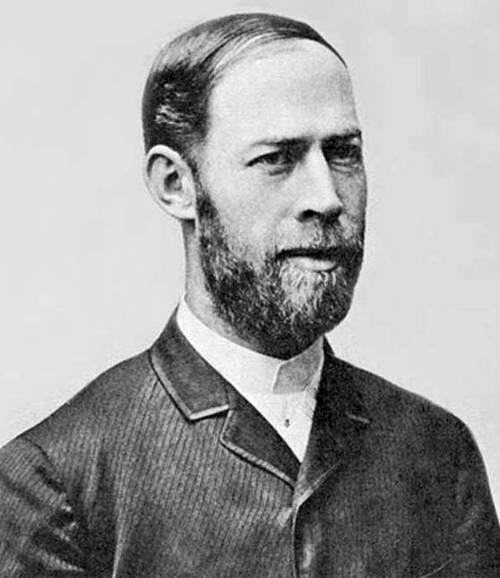
FAQ About Heinrich Hertz

Who was Heinrich Hertz?
Heinrich Hertz was a German physicist born on February 22, 1857, in Hamburg, Germany. He is best known for his groundbreaking work in the field of electromagnetic theory. Hertz's experiments conclusively proved the existence of electromagnetic waves, validating James Clerk Maxwell's theory of electromagnetism. His work laid the foundation for the development of radio, television, and radar technologies.

What is Heinrich Hertz known for?
Heinrich Hertz is primarily known for proving the existence of electromagnetic waves. In 1887, he conducted experiments that demonstrated these waves could be generated and detected in the laboratory. His discoveries confirmed James Clerk Maxwell's theoretical predictions about electromagnetism and paved the way for the future development of wireless communication.

How did Heinrich Hertz discover electromagnetic waves?
Heinrich Hertz discovered electromagnetic waves through a series of experiments in the late 1880s. He used an apparatus consisting of a spark gap transmitter and a receiver to demonstrate that electromagnetic waves could travel through air. By showing that these waves produced effects similar to light, such as reflection and refraction, Hertz empirically confirmed the electromagnetic theory proposed by Maxwell.

Why are electromagnetic waves important?
Electromagnetic waves are crucial because they form the foundation of modern communications technologies. They include radio waves, microwaves, visible light, and X-rays, among others. Hertz's discovery of these waves enabled the development of radio, television, radar, and later cellular and satellite communications, revolutionizing the way information is transmitted and received across the world.

What impact did Heinrich Hertz's discoveries have on technology?
Heinrich Hertz's discovery of electromagnetic waves had a profound impact on technology, enabling the creation of modern communication systems. His work laid the groundwork for the development of radio and television broadcasting, radar technology used in navigation and surveillance, and various wireless communication systems, including mobile phones and Wi-Fi.

What experiments did Heinrich Hertz conduct to prove electromagnetic waves?
Hertz conducted experiments using a spark oscillator connected to a dipole antenna as a transmitter and a similar setup as a receiver. He observed the production of sparks at the receiver when the transmitter emitted sparks, proving that electromagnetic waves could travel through space. He further showed these waves could be polarized, reflected, and refracted, confirming their similarity to visible light.

What is the significance of Hertz's work in modern physics?
Hertz's work is significant in modern physics as it provided empirical evidence for Maxwell's theory of electromagnetism, which is a cornerstone of classical physics. His discovery of electromagnetic wave propagation led to the development of quantum mechanics and relativity, influencing both theoretical and applied physics. Many technologies that form the basis of modern life rely on principles emerging from Hertz's findings.

How did Heinrich Hertz's discovery confirm Maxwell's theory?
Heinrich Hertz's experiments confirmed Maxwell's theory by demonstrating that, as Maxwell predicted, electromagnetic waves could propagate through space. Hertz showed that these waves exhibited similar properties to light, such as speed, polarization, and reflection, effectively proving that electricity and magnetism were interrelated phenomena that traveled at the speed of light.

What is Hertz's legacy in the field of communications?
Hertz's legacy in communications is profoundly impactful. His experiments and subsequent discovery of electromagnetic wave propagation directly led to the development of wireless communication technologies, such as radio, television, and radar. These technologies have advanced global connectivity, information dissemination, and surveillance capabilities, forming an integral part of modern communications infrastructure.

What awards or recognitions did Heinrich Hertz receive for his contributions?
Heinrich Hertz received several accolades during his career. Notably, he was honored with the Matteucci Medal in 1888 and the Rumford Medal in 1890. These recognitions were due to his revolutionary contributions to the understanding of electromagnetic phenomena and his experimental work providing insights into wave theory.

How did Hertz's discoveries influence the development of radio technology?
Hertz's discoveries directly influenced radio technology by proving that electromagnetic waves could be generated and transmitted. This understanding prompted researchers like Guglielmo Marconi to invent practical wireless telegraphy systems. The ability to send and receive signals over long distances without physical connections revolutionized global communication, leading to the establishment of radio broadcasting.

What challenges did Heinrich Hertz face in his experiments?
Hertz encountered several technical challenges during his experiments, including generating and detecting electromagnetic waves with the technology available in his time. His work involved meticulous experimentation and innovation, using primitive equipment that he modified to refine his experiments and achieve clear demonstration of electromagnetic wave propagation.

What devices did Heinrich Hertz invent or improve upon in his experiments?
Hertz invented several devices to conduct his experiments, notable among them were the spark-gap transmitter and receiver, which were pivotal in his discovery of electromagnetic waves. He optimized his apparatus to demonstrate the wave-like characteristics of these signals, such as reflection and refraction, integral to confirming Maxwell's theories on electromagnetism.

Did Heinrich Hertz contribute to any other fields of science?
Besides electromagnetism, Hertz made contributions to other scientific areas, including the study of cathode rays and mechanics. His research on the elasticity of solids and his clarification of the photoelectric effect were important, later influencing Albert Einstein's work. Hertz's broad scientific work illustrated his versatile approach to physics.

What other scientific areas were influenced by Hertz's work?
Hertz's work influenced numerous scientific areas beyond electromagnetism, such as the development of quantum mechanics and understanding of light. His clarification of the photoelectric effect, where he observed light affecting electrical circuits, laid foundational concepts later used by Einstein in the realm of photoelectric science and quantum theory.

How are Hertz's contributions recognized in modern units or terminology?
Heinrich Hertz is honored in the field of physics through the unit of frequency named after him: the hertz (Hz). This unit measures the number of cycles per second of a periodic phenomenon, such as sound waves or radio signals, paying tribute to Hertz's pivotal role in advancing the understanding of electromagnetic wave propagation.

What educational background did Heinrich Hertz have?
Heinrich Hertz had a robust academic background; he studied engineering and physics at institutions such as the University of Dresden and the University of Munich. He earned his doctorate in physics from the University of Berlin, where he studied under the guidance of eminent physicist Hermann von Helmholtz. His thorough scientific training equipped him to make his groundbreaking discoveries.

Where can I find Heinrich Hertz's published scientific papers?
Heinrich Hertz's scientific papers can be found in various academic publications and archives. Key papers and experimental findings are often cited in physics textbooks and research articles. Libraries with collections on the history of science, as well as digital archives dedicated to physics, can also serve as resources for accessing his work.

Was Heinrich Hertz's work immediately recognized by his contemporaries?
Initially, Heinrich Hertz's work garnered limited attention, but it gradually gained recognition among physicists for its profound implications. Although his career was brief—Hertz died young at 36—his experimental validation of electromagnetic waves soon became a cornerstone of the scientific community, leading to widespread acclaim and influencing future generations of scientists.

How did Hertz's findings impact the understanding of light?
Hertz's findings greatly enhanced the understanding of light by linking it with the wider spectrum of electromagnetic waves. He demonstrated that light was merely a subset of electromagnetic radiation, possessing wave-like characteristics. This understanding paved the way for subsequent advancements in optics, communication technologies, and quantum physics.
